Over the last several years, my fascination with what the French call “cartonnage” has steadily grown.
What apparently began as a technique for creating funerary masks in Ancient Egypt has developed today into the craft of box-making, using different weights of card and board (like book-binding board or mat board) covered with fabric or paper to create beautiful receptacles, organizers, trays, etuis, and the like.
Today, I want to show you a book that will help you do all of the above. I have a pretty thorough collection of books dedicated to making fabric (or paper) covered boxes, and when this one came out, I knew I had to add it to my shelf! I’m glad I did, because I found within its pages many tidbits that have made me much more confident about undertaking my next box construction project.
If you have an obsession with creating embroidered, fabric, or paper-covered boxes, Embroidered Boxes: Techniques and Projects by Emma Broughton is well worth adding to your own library!
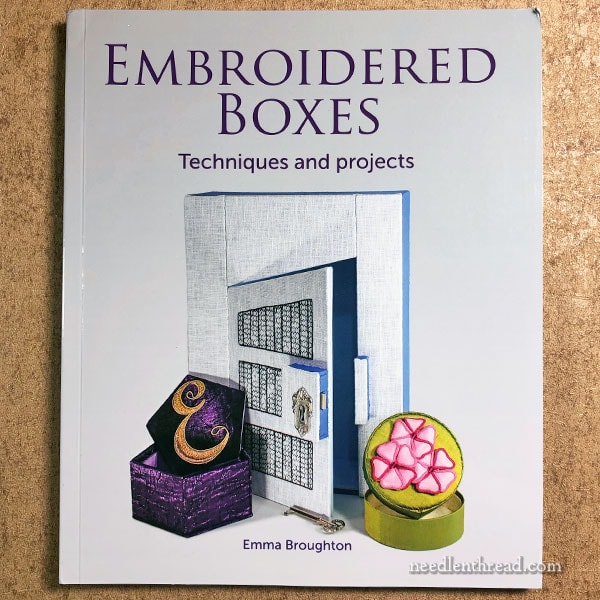
I love the whole concept of box-making. Still, although I’ve dabbled with some very basic constructions, I have yet to make the Magnum Opus of Boxes that I have floating around in my head.
I think, to get to the point of making a really great box, you have to journey through stages of learning. It’s just like any craft, really – you’ve got to start basic, master the foundational techniques, and move up through the ranks to the more complicated projects.
Embroidered Boxes is a book arranged to help you do that. It begins with the very basics and takes the learner ever-upwards to the more complex styles of box-making.
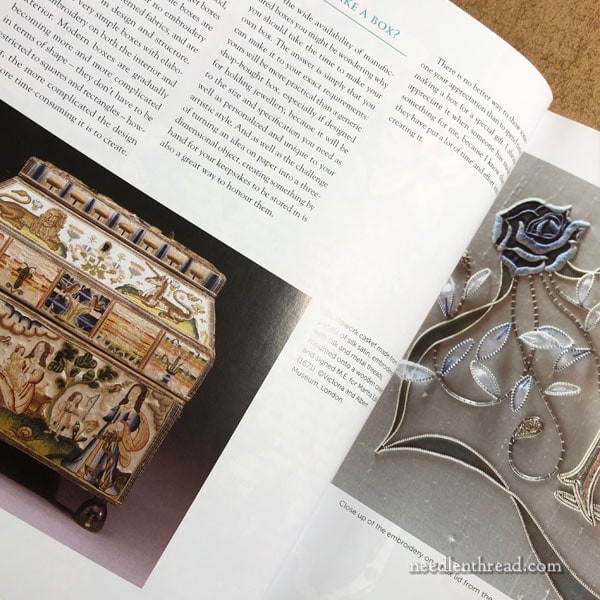
Of course, the book begins with a history of the embroidered box, taking the reader back to the 17th century, where the embroidered “casket” was often a culminating exercise in the learning of needlework skills for a young lady.
This book focuses on modern box-making projects, though, with projects like jewelry boxes, small storage and organizational boxes, gift boxes, treasure boxes, and the like. The examples have a streamlined, modern look to them and they are all functional and decorative.
While techniques that reach back to the boxes of earlier centuries (like adding doors) are covered, the book doesn’t focus on 17th century box making styles (just to be clear).
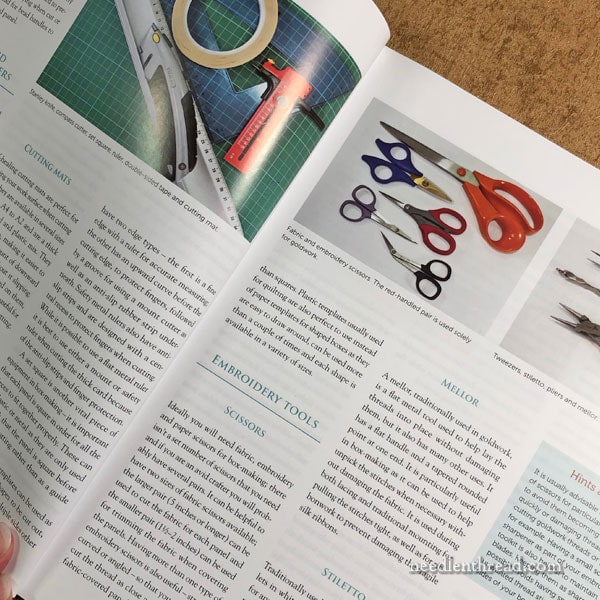
At the beginning of the book, we also get a very thorough section on supplies used in box making and supplies used in embroidery. The book, after all, focuses on embroidered boxes, so embroidery does figure into the contents.
That said, the embroidery part of the book is not the primary focus. It would be too much information to contain in one book, to cover all the basics of embroidery. So, while the embroidery for the projects is made accessible, there’s no step-by-step instructional content (with photographs) on the embroidery. All the step-by-step instructional content focuses on the box making.
I’m glad of that. I think the book would have been bogged down with too many details, had the embroidery been of equal focus with the box-making.
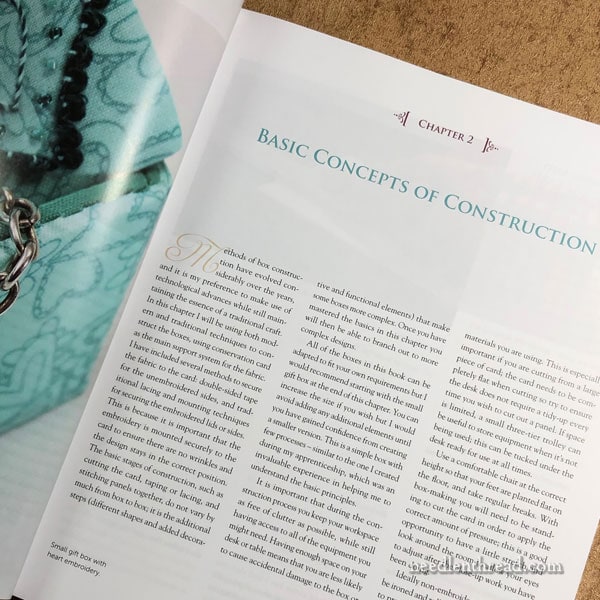
Getting into the meat of the instructional content, we start with a very basic box construction techniques.
In this section, all the techniques to build a box are presented, and you’ll end up referring back to this section frequently while reading the rest of the book.
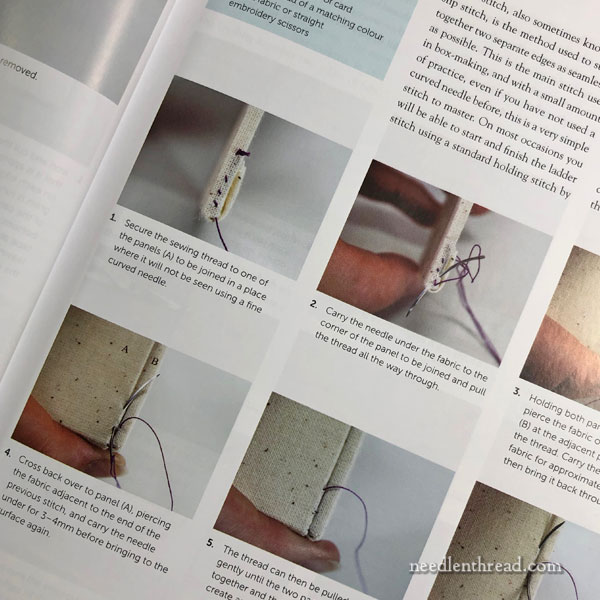
The instruction is presented in clear step-by-step photos with lots of accompanying text to explain procedures.
What you’ll learn in this section, you’ll apply on pretty much every box-making project, so it’s a good idea to read this section thoroughly and get acquainted with what’s in it. That way, when you tackle a project, you’ll know where to go to find help should you need it.
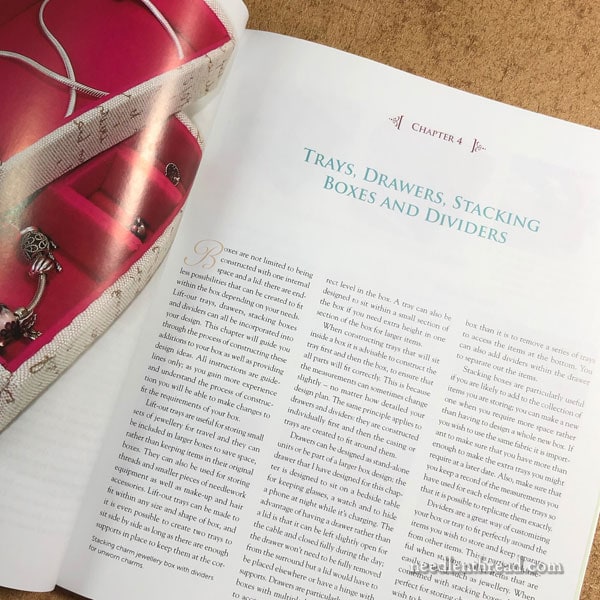
Then we add different levels of complication to the boxes – like making boxes that have dividers, that stack on the inside, and so forth.
We learn how to construct boxes with open sides, like etuis and other similar specialty boxes.
We learn how to make shaped boxes (round boxes, hexagons, and so forth). And we learn advanced construction techniques, which including adding doors, drawers, locks and so forth.
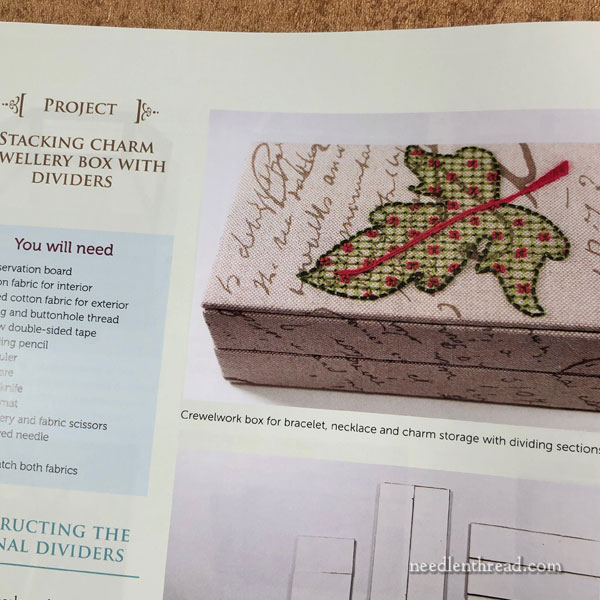
Throughout the construction content, the book covers various projects, which range from simple to complex, to match the techniques covered.
Each project features some kind of embroidery.
The project instruction begins with a materials list and an overview. We are directed to a later chapter of the book for information about the embroidery – the design and a guide for stitching it, along with access to the stitch glossary.
And we’re taken step-by-step (usually with photos) through constructing the box for that particular project.
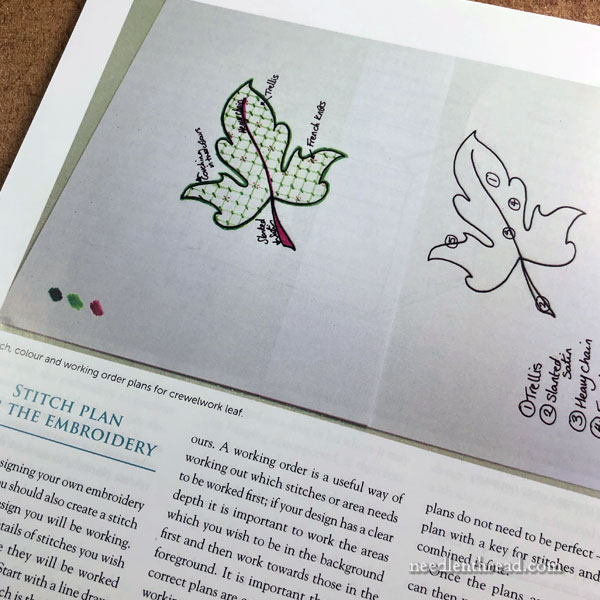
As mentioned early, the embroidery instruction is not too in-depth. But it is more than adequate! There’s also a stitch glossary in the back of the book.
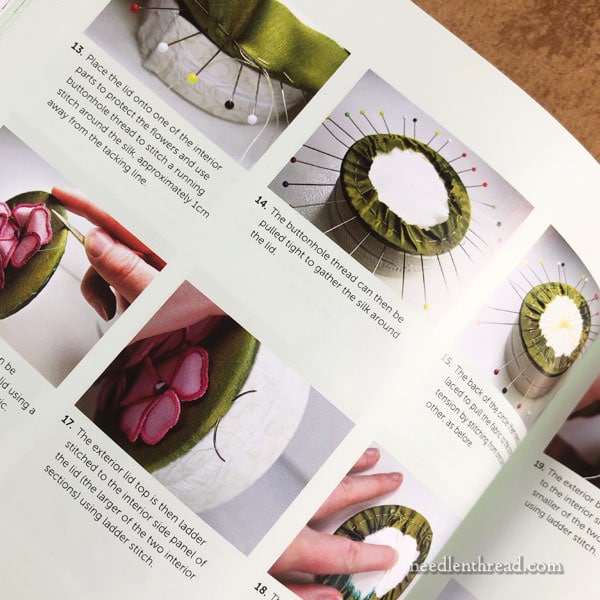
In some cases, as the boxes become more complicated, so does the embroidery, but this isn’t always the case. Very simple boxes can be used to show off complex embroidery, while very simple embroidery can accent a more complicated box.
Once you figure out the nuances of box construction, it’s up to you how you want to make use of your new-found knowledge and skills as a showcase for your stitching.
At the end of the book, there’s also an good chapter on designing your own box. This is where I picked up some great tips for designing the box that’s been floating in my head!
More Information & Where to Find It
You’ll find Embroidered Boxes listed here on my Amazon Recommendations page.
Here’s a direct link to the book on Amazon, if you want to go straight there.
Worldwide, with free shipping, you can find the book here on Book Depository.
I’ve also listed several other books on cartonnage on my Amazon Recommendations page. I have all of these books and each one is excellent in its own way, for teaching the skills of covered box-making. Some are more complex than others and will provide you with more thorough information. If you’re looking for thorough instruction that ranges from simple to complex, Embroidered Boxes (this book I’m reviewing today) and Cartonnage: Basics & Beyond are my favorites. They are both really good instructional books.
I plan to explore this topic further. I promise to share all my excursions with you as they develop!
This article contains affiliate links to book sources, which means that Needle ‘n Thread receives a small commission for any purchases made through those links, at no added expense to you. Thanks!


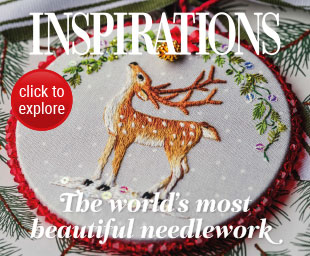
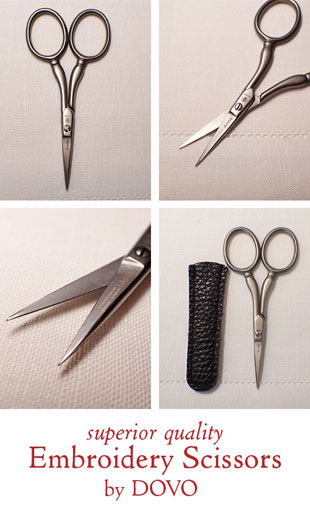
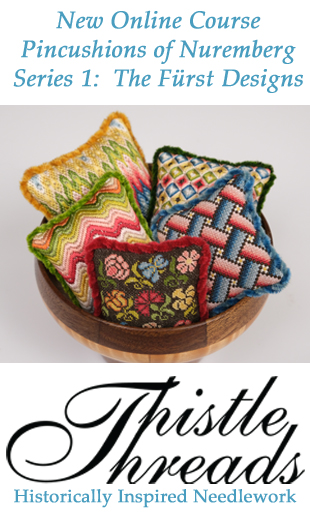


Thank you Mary! A long time ago I covered a wooden cheese-wheel box w fabric and lace. I was just asking a friend if she knew where to find those boxes and along came this pretty book. I will purchase at probably Book Depository and help you w your review efforts. My best Mary! Margaret
Dear Mary
Embroidered Boxes: Techniques & Projects seems an exceptional book for those who are interested in box making and embroidery. I like the photos which demonstrate how to cover boxes with fabric, good photographic instructions which I like and lovely photos of the embroidered casket. I look forward to your future project on box making/fabric covering it will be interesting to watch the approach you take, maybe I might get into it. But I’m thinking of delving into Medieval embroidery and will look at resources available. Thanks for sharing with us this lovely book on box techniques and for the photos and links.
Regards Anita Simmance
Mmm … maybe I should focus on making boxes … ? I adore them, but most of all they are something I really could give away … while the usual embroidered items, such as basket linens, tablecloths, handkerchieves etc. are not exactly held in high esteem over here … but boxes! with dividers and other various extras to boot & beautifully embroidered – oh yes, I think everybody would be delighted at them.
Thanks for the great inspiration, Mary!
Angela from the Ore Mountains
Thank you for identifying this book. I have been buying books on cartonnage for several year, but have never stuck my toe in the water! I started with the French books (NOT always translated), as I first saw these boxes in French publications.
I found out about Claudia Squio’s book (CARTONNAGE; Basics and Beyond) in a post from Sherri Jones. In reading it and following Claudia, I really think I can do this. I was not aware of this older book, using basic to advanced construction. Anything in English is a help! I want to thank you for this wonderful blog, where I ALWAYS learn something new.
Morning Mary ~ what a wonderful article reviewing this book. Back in the early ’80’s, my sister and I took an all day class and made a rather complicated octagonal box (about 5″ deep) all fabric covered, divided in the bottom, a lift out tray rested on that and then a heavily padded, cushion top lid. We learned many techniques during this class and everything was glued together. We both of us have a love of pretty but practical boxes to keep things in.
I see from one of the first pictures that these boxes are sewn together, a much nicer finish than our newspaper tabs and white glue method. (In defense of this technique, we had but one day to complete the box. With multiple layers of construction cardboard, it’s sturdy, and with cotton yardage, it’s pretty.) This, to me, is an indicator of what the finished piece will look like when put together with care and skill and I’d be really interested in reading how to design your own box.
As you say, this is a ‘must have’ for my bookshelf and maybe next time sis and I spend a week together, we’ll be making another box. In fact, I’m looking forward to it. I’d love to see what you’re dreaming up, I’m sure it’ll be efficient in it’s design with all needs considered and included (kind of like designing a house really) and at the same time beautiful.
Thank you again and take care ~ Brenda
Listen to an interview with Broughton, catch up at 2:00
Stitchery Stories
Glad you gave this link to the 39 min. audio. What a nice background to this successful new artist/author. I’ve placed my order with Amazon & will patiently wait ’til mid-July delivery.
Thank you so much for posting this! I am always looking for new ways to use embroidered pieces, and this is such a great idea. I scour thrift stores for old boxes with cut-out sections for quilted or embroidered pieces, but never considered just making a box myself. I will definitely add this book to my wish list. Thanks again!
Hello Mary
A lovely balanced review as always.
Ordinarily I would have skimmed this as it is not something I might attempt but just yesterday I was at Sudely Castle in the UK admiring embroidery displays of many types but most especially a 17th century stumpwork and embroidery sewing box!!
It was exquisite and accompanied by a video demonstrating the lining and many compartments within.
I would highly recommend a visit for this alone!
Many thanks for your fabulous site
Helen S
Ahhhhhh…. I would love to see that display!
Thanks for another great book review Mary! I have always wanted to make my own cross-stitched and embroidered boxes and I’m so thrilled that this book is on the market. I was extra pleased to learn, when I looked it up, that the RSN is putting out a guide called called “RSN: Embroidered Boxes”, by Heather Lewis, in 2020 – and I’m looking forward to your review of that one too, when the time comes 🙂
I’m looking forward to seeing that one, too!!
I am commenting contemporaneously this time, Mary. A well timed article for me, because I have had my mind on how to finish embroidery with something other than frames. Boxes have been on my mind a lot, because I have a box full of unframed pieces that have been sitting in storage waiting to see the light of day once again. My taste has changed over the years, but I’m hoping that the right finishes may save some my old timers. Everything old can, under the right circumstances, be new again.
And my wish list just got longer again 🙂 Even without seeing the book, I think I’m glad box construction and design is is the focus, not embroidery. I can see covering a box in beautiful fabrics or quilt blocks also. Or making trays for a box you already have.
The book is already pretty extensive – it would have been HUGE if she had gone in-depth with the embroidery. There are some areas (like the intro, where she gets into supplies for embroidery) where I think she could have cut down on the content a bit. It’s the type of book, I think, where it’s ok to assume that the box maker already has some handle on the whole embroidery notion! And yes, you’re right – plenty of scope for other materials besides embroidery. Even paper! I saw some Fantastic hand made cotton papers at an art store last week – they would look fabulous on a box like the ones featured in this book!
Thanks Mary for recommending my book Cartonnage Basics & Beyond. I’m so glad you liked it! Making fabric boxes is so much fun. I’m also passionate about embroideries and how the boxes are wonderful when we add them… I have made some to encourage my talented students to do that with their beautiful embroideries. The possibilities are endless… so many ideas and ways that we can have fun and make unique projects combining cartonnage with embroideries. Thanks again!
Hope the commission from Amazon does get credited to you as your photos & description of this book propelled me to order. I probably become motivated every decade to construct boxes (Jane Lemon’s Embr’d Boxes in paperback from 1986, and 10 years later Meg Evans Hand-Stitched Boxes) so the curved needle photo detail and that there are drawers and dividers and silver paperclay latches encouraged me again.